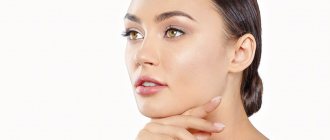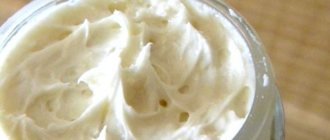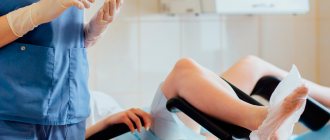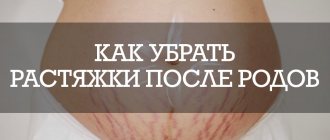Pregnancy and breastfeeding are processes that are regulated by the release of certain hormones in a woman’s body. But the effect of hormones is usually not limited to any one specific function; they almost always have a complex, multifaceted effect on a wide variety of organs and tissues. These include the skin, on which, in some cases, a large number of rashes may appear. We will tell you in this article what to do if after childbirth there is a lot of acne on the face and hands, what are the causes and treatment for this during breastfeeding.
Why does hormonal imbalance occur after childbirth?
Childbirth itself is already a cause of hormonal imbalance. But recovery may take longer for the following reasons:
- difficult childbirth;
- lack of milk;
- illnesses suffered in the first months after childbirth;
- stress;
- drug use;
- unbalanced diet;
- smoking, alcohol consumption.
A woman wants to quickly return to her old life, so she often harms her body by not giving it time to recover. Thus, mothers who immediately after childbirth go to work, start smoking or go on a strict diet, dreaming of saying goodbye to the extra pounds gained during pregnancy, are at risk.
Another situation is also possible. The woman devotes all her strength to the child, eats and sleeps poorly, practically does not rest, is nervous, neglects self-care (which can also cause acne).
Excess weight
During pregnancy, a woman gains on average 7-16 kg. This is due to the fact that the baby’s weight increases and the uterus enlarges. It is also worth taking into account the weight of the amniotic fluid and placenta. But there is another explanation - hormonal changes, eating disorders, physical inactivity.
You cannot go on a diet immediately after giving birth. If a woman is breastfeeding, her diet largely determines whether the baby will receive the vitamins, microelements, and other useful substances he needs. It is necessary to balance your diet and maintain a drinking regime (the norm is 1.5-2 liters of still water per day).
It is not recommended to actively engage in sports immediately after giving birth. Only 1.5-2 months after the birth of the baby can you start going to yoga, Pilates, and walking, while the load should be minimal. Heavy exercise is especially contraindicated for women who have undergone a cesarean section and nursing mothers, since active sports can reduce the level of prolactin, which is responsible for milk production.
Signs of hormonal imbalance
3-4 months after birth, hormonal levels gradually return to normal. During this period, it is necessary to analyze your physical well-being, emotional and mental state.
Symptoms of hormonal imbalance include the following:
- sudden mood changes;
- nervousness, a state when tears well up in the eyes by themselves;
- sudden outbursts of aggression;
- hair loss;
- feelings of guilt, painful thoughts (about the inability to be a good mother and wife, etc.);
- a sharp jump in weight (lack or excess);
- pathological suspiciousness;
- depressed mood;
- problems with breastfeeding, including lack of milk;
- reluctance to breastfeed;
- painful menstruation;
- acne;
- hyperpigmentation;
- decreased libido.
If these symptoms occur, you should consult your doctor.
Stretch marks
Striae during pregnancy occur not only because the skin quickly stretches. In fact, the skin has a high level of ductility, but due to hormonal disruptions caused by pregnancy, it loses its elasticity. With an increase in estrogen in the body, the number of amino acids in the dermis decreases. Because of this, the level of collagen and elastin production decreases.
An increase in cortisol causes existing elastin fibers to become weak and brittle. In place of the torn elastin fibers, connective tissue is formed. At first, the stretch marks are pink, but over time they turn white.
To reduce the risk of their occurrence, even during pregnancy it is necessary to thoroughly moisturize the skin. It is impossible to remove stretch marks that have already appeared, but with the help of cosmetic procedures they can be made less noticeable.
Acne* after childbirth: how to get rid of it?
If acne appears after childbirth, you should consult a doctor. He will prescribe the most gentle treatment, including one aimed at normalizing hormonal levels. Under no circumstances should you self-medicate during pregnancy or breastfeeding.
At the end of the lactation period, a dermatologist may prescribe topical medications, such as azelaic acid, to treat acne5,9. Azelik® is an azelaic acid gel5. It reduces the concentration of free fatty acids on the skin, normalizes the keratolytic processes occurring in the follicles5.
The drug exhibits antimicrobial activity against Propionibacterium acnes and Staphylococcus epidermidis5. The anti-inflammatory effect of Azelik® gel can be explained by the ability to reduce the metabolism of neutrophils and reduce their production of free radical forms of oxygen5.
*acne
What can't you do?
- Under no circumstances should you pick off pimples with your nails, scratch them, or use harsh peels. It is necessary to remember that a small scar will form at the site of the pimple, which will be extremely difficult to get rid of. The only effective method to remove scars is resurfacing, similar to laser removal of papillomas.
- You shouldn't spend a lot of time in the sun without sunscreen. Despite the fact that these defects are not so noticeable on tanned skin, ultraviolet radiation can play a cruel joke on you, staining young skin at the site of scars. As the tan fades on the forearms and shoulders, the skin will remain with a clear pigment pattern.
Treatment of acne in pregnant and breastfeeding women
When visiting a dermatologist, women most often receive a recommendation to postpone treatment until after pregnancy and lactation, although there are completely safe remedies and methods of treatment. Cosmetologists are either “cautious”, resorting to the most neutral, and therefore useless, care, or they believe that there can be no harm from professional care. The purpose of this publication is to clarify the problem of care and treatment of acne in pregnant and breastfeeding women.
Pregnancy
An exacerbation of the disease usually occurs in the 1st–2nd trimesters of pregnancy. The reasons for the exacerbation are the abolition of the most effective systemic anti-acne agents (retinoids, hormonal contraceptives, antiandrogens), the cessation of the use of local retinoids, an increase in testosterone levels, as well as the active use of folic acid both in preparation for pregnancy and during pregnancy.
The level of androgens, in particular testosterone, gradually increases during pregnancy; by the 3rd trimester, the concentration of free testosterone in the blood doubles.
Under the influence of increased testosterone levels, the sebaceous glands become more active, an increase in skin oiliness is observed, and the rash becomes more profuse. Inflammation during pregnancy is more pronounced, but the inflammatory elements themselves (papules, pustules, nodes) resolve more quickly, and the likelihood of scar formation is reduced. Places where there were previously foci of inflammation are easily pigmented, so you need to be more careful about the use of photoprotective agents.
Difficulties in prescribing certain drugs - both externally and systemically - are associated with the lack of clinical studies, pharmacokinetic data during pregnancy, inconsistency of recommendations and the lack of a unified approach to the treatment of pregnant women1,2. Let us consider the safety profile of the most commonly used external agents for treatment, since they will be the main ones in the treatment of pregnant women (Table 1).
Benzoyl peroxide (Baziron AS gel 2.5% and 5%, Proactive) has keratolytic, antimicrobial, anti-inflammatory and comedolytic activity. The antimicrobial effect is achieved through the formation of oxygen radicals in the skin. About 5% of the applied drug is absorbed from the surface of the skin3, but inside the skin benzoyl peroxide is converted into safe benzoic acid, which is excreted in the urine, therefore the use of benzoyl peroxide in pregnant women is considered safe1,4. Due to the pronounced irritating and drying effect, it is better to use a gel of lower concentration (2.5%), apply it locally, to individual rash elements.
External retinoids (Retasol solution, retinoic ointment 0.1% and 0.05%, Differin gel and cream, Klenzit gel, as well as combination preparations Isotrexin, Klenzit S, Effezel) are poorly absorbed from the skin surface, but isolated cases have been described in the scientific literature the birth of children with deformities similar to those resulting from systemic treatment with retinoids. In this regard, external retinoids should not be used during pregnancy. Their use is stopped as soon as pregnancy is confirmed. At the stage of pregnancy planning, the use of external retinoids is not contraindicated.
There are few local preparations with antibiotics - Zinerit solution (contains erythromycin), as well as Dalacin and Klindovit gels, Zerkalin solution (contains clindamycin). External use of erythromycin is considered safe. Clindamycin inhibits the synthesis of bacterial proteins by attaching to their ribosomes and is also safe during pregnancy4. However, one should keep in mind the frequent resistance of microbial flora to local antibiotics. Zenerit is usually prescribed first. If its effectiveness is insufficient, clindamycin preparations can be prescribed, which are active in cases of resistance to erythromycin.
Azelaic acid (Skinoren gel 15% and cream 20%, Azelik gel 15%, Azix-derm cream 20%, Acne-derm cream 20%) inhibits the growth of Propionibacterium acnes, reduces the amount of fatty acids in sebum. Resistance does not develop to azelaic acid, it has a moderate lightening effect, is not detected in the systemic circulation and can be used during pregnancy and lactation. Disadvantages include irritation, dry skin, burning and tingling during application, especially in the initial stage of treatment, lack of effect on sebum secretion and slow onset of effect. With an adequate selection of cosmetics, these disadvantages can be overcome.
Salicylic acid (2–3% salicylic alcohol, salicylic lotion, gel, pencil) has an antiseptic and anti-inflammatory effect. When used systemically, salicylic acid is teratogenic (defects in the structure of the heart in the fetus are possible), but when applied topically, the effect on the fetus is not described. Application to individual pouring elements is possible.
External zinc preparations (Curiosin gel and solution, Regetsin gel, Cynovit spray and acne cream gel) have a moderate anti-inflammatory effect, the effect on the fetus has not been described, however, the use of Curiosin is prohibited during pregnancy, and other drugs are recommended to be used with caution.
Local 5-α reductase inhibitor (Clirogen lotion) contains β-sitosterol in the extract of saw palmetto, α- and γ-linolenic acids (restore the epidermal barrier), purified sulfur 3%, can be used during pregnancy and lactation.
Prescription sulfur-containing prescriptions can be used on limited areas of the skin at any stage of pregnancy, and Delex-acne gel for acne (contains sulfur, plant extracts, menthol) - with caution due to the presence of menthol.
Iodine preparations (Betadine 10% solution) are not recommended from the 3rd month of pregnancy.
External products containing glycolan (lanthanum compound) in the form of Eplan and Kvotlan creams, which have antibacterial and healing activity, can be used.
Systemic therapy during pregnancy is limited (Table 2). Features of metabolism during pregnancy are a slowdown in gastric emptying, an increase in plasma volume and an increase in renal blood flow. In this regard, the absorption of drugs is reduced, their concentration in the blood decreases and elimination is accelerated4.
The most effective group of antibiotics for acne are tetracyclines (Tetracycline hydrochloride, Doxycycline, Unidox Solutab, Minolexin). However, in the 2nd–3rd trimesters of pregnancy, tetracyclines cause discoloration of teeth and bones, and fatty degeneration of the fetal liver is possible; therefore, their use is prohibited during pregnancy. Erythromycin is permitted, but its use is limited by the frequent resistance of microbial flora; it is recommended to combine it with local therapy5. Vilprafen (josamycin) is approved after a medical assessment of the benefit/risk, that is, its use is limited. Clindamycin and Lincomycin (a group of lincosamides) pass through the placenta and can concentrate in the fetal liver, but no adverse effects of such accumulation have been recorded and no teratogenicity has been detected. Frequent side effects such as diarrhea, colitis, and increased risk of Clostridium difficile infection limit the use of lincosamides. The safety of azithromycin during pregnancy has not been proven, so the antibiotic is used “only if there are no alternatives.” Sulfonamide drugs (Trimethoprim) are teratogenic and prohibited.
Zinc preparations (Zincteral, Zinkit) have anti-inflammatory activity by inhibiting the expression of toll-like receptors TLR2. During pregnancy, the body's need for zinc is increased due to its use during embryogenesis and fetal development. Taking zinc supplements during pregnancy is recommended if there is a zinc deficiency in the body, but is not contraindicated even without a pronounced deficiency6.
Pantothenic acid (vitamin B5) reduces the number of rashes through its metabolite CoA, which affects sebum secretion and improves the epidermal barrier, recommended during pregnancy, prescribed in a dose of 1.0 g (2 capsules) 2 times a day.
Home care products should not contain retinol, retinoic acids, retinaldehyde, vitamin A, hydroxy acids, hormones, placenta, growth factors, or essential oils as active ingredients. Some auxiliary components are also undesirable - sodium lauryl sulfate (more than 2%), mineral oil (ceresin, microcrystalline wax, dimethicone, petrolatum), benzene, parabens, glycols, formaldehyde, bronopol7.
During pregnancy, you should not use skin lightening products, especially those containing hydroquinone (its systemic absorption is 35–45%) and its derivatives (arbutin), and kojic acid is also prohibited. At the same time, given the high ability of pregnant skin to pigment, especially in areas of resolved acne, the use of sunscreen is mandatory. Sunscreens and emulsions do not affect the body of the woman and the fetus. But preference should still be given to wide-brimmed hats, sunglasses and the ability to avoid direct sunlight. Self-tanning products (bronzants) often contain dihydroxyacetone, which is harmful during pregnancy. To remove hair, it is better to use a razor; photoepilation and chemical depilators (containing thioglycolic acid) are contraindicated. It is not advisable to use hair dyes during pregnancy.
Breastfeeding period
The increase in the number of rashes during lactation is explained by the fact that after childbirth the amount of estrogen and progesterone sharply decreases, and testosterone levels decrease gradually during the first 2-3 months after childbirth.
During breastfeeding, it is possible to expand the range of external acne remedies by including external zinc preparations (Curiosin, Regetsin, Cynovit). The use of external agents with clindamycin is limited; among external antibiotics, only erythromycin (Zinerit solution) is allowed. Tetracyclines are contraindicated due to their adverse effect on the formation of tooth enamel in a child; erythromycin is also contraindicated during lactation8.
——————— 1 Pugashetti R., Shinkai K. Treatment of acne vulgaris in pregnant patients. // Dermatol Ther. 2013 Jul-Aug; 26(4):302-11. 2 Kong YL, Tey HL Treatment of acne vulgaris during pregnancy and lactation. // Drugs. 2013 Jun; 73(8):779-87. 3 Nacht S., Yeung D., Beasley JN et al. Benzoyl peroxide: percutaneous penetration and metabolic disposition. // J Am Acad Dermatol. 1981; 4(1):31–7. 4 Meredith FM, Ormerod AD The Management of Acne Vulgaris in Pregnancy // Am J Clin Dermatol. 2013; 14:351–358. 5 Thiboutot D., Gollnick H., Bettoli V. et al. New insights into the management of acne: an update from the Global Alliance to improve outcomes in acne group. // J Am Acad Dermatol. 2009; 60(5 Suppl.):S1–50. 6 Dréno B1, Blouin E. Acne, pregnant women and zinc salts: a literature review.// Ann Dermatol Venereol. 2008 Jan;135(1):27-33. 7 Bozzo P., Chua-Gocheco A., Einarson A. Safety of skin care products during pregnancy. // Can Fam Physician. 2011 Jun; 57(6):665-7. 8 Bayerl C. Acne therapy in pregnancy. // Hautarzt. 2013 Apr; 64(4):269-73.











